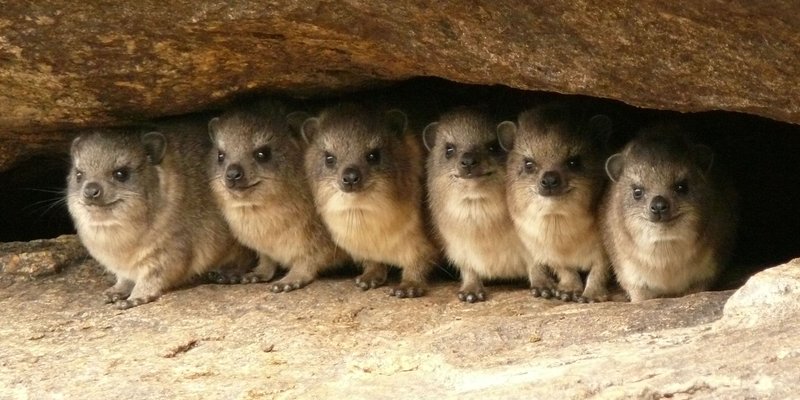
Imagine having to navigate life on a rocky mountain face, where the sun can be blistering hot during the day and chilly at night. That’s the world of the rock hyrax, and their survival strategies are nothing short of fascinating. Let’s dive into how these little mammals manage to endure and flourish in such demanding environments.
Physical Adaptations That Help Rock Hyraxes Thrive
Rock hyraxes have a stocky build and short legs, which might seem cute, but these features serve important purposes. Their bodies are compact, enabling them to conserve heat when the temperatures drop at night. This compact shape also helps them navigate the rocky terrain, making it easier for them to find hiding spots and shelter.
You might also notice that their fur is thick and coarse. This isn’t just for looks! The thick coat provides insulation against the cold and protection from the sun’s rays. It’s almost like they’re wearing a cozy jacket that keeps them warm when the weather gets tough. And let’s not forget about their padded feet, which allow them to grip slippery surfaces and leap between rocks with agility.
Social Behavior and Group Living
Another interesting aspect of rock hyrax survival is their social behavior. These animals are often found in groups, known as colonies. Living in a colony offers several benefits. For one, it’s easier to spot predators when you have several sets of eyes watching out. This social structure creates a supportive community where hyraxes can groom each other, strengthen bonds, and care for the young.
When it comes to communication, rock hyraxes have a variety of vocalizations. They can use different sounds to alert their group about danger or to establish their territory. Honestly, it’s like they have their own little language! This communication enhances their survival chances, as a well-informed group can respond quickly to threats.
Diet and Foraging Strategies
Rock hyraxes are herbivores, feeding on a diet rich in grasses, leaves, and fruits. You might wonder how they find enough food in rocky, dry environments. Well, they’ve adapted their foraging strategies to suit their surroundings. For example, they are excellent climbers and can reach vegetation that’s out of reach for many other animals.
They tend to forage in the early morning or late afternoon when temperatures are cooler. This helps them avoid the scorching midday sun and reduces their water loss. They’ve also been observed eating the droppings of other animals to extract extra nutrients. It’s like a second chance at a meal! This cleverness contributes to their ability to thrive where food can be scarce.
Water Conservation Techniques
Water is precious in harsh environments, and rock hyraxes have developed remarkable techniques to conserve it. They can survive for long periods without drinking fresh water. You might be surprised to learn that they are excellent at extracting moisture from the plants they eat. This ability allows them to stay hydrated even when water sources are few and far between.
Moreover, their bodies are adapted to minimize water loss. By being active during cooler parts of the day, they reduce evaporation. Their thick fur also plays a role in retaining moisture. It’s a smart way of ensuring that their bodies can function optimally without needing frequent water intake.
Predation and Escape Strategies
Rock hyraxes have several natural predators, including eagles, leopards, and snakes. To deal with these threats, they rely on their agility and their ability to find shelter in rocky crevices. You can picture them darting between boulders like little acrobats, using their climbing skills to escape danger.
Additionally, their alertness plays a crucial role in avoiding predators. They often keep a lookout while others eat or rest. If they sense danger, they let out a warning call that sends the entire colony into a frenzy, leading to quick escapes. This coordinated response highlights their teamwork and enhances their survival chances significantly.
Habitat Preferences and Environmental Adaptations
Rock hyraxes prefer rocky terrains where they can find ample shelter and food. They often inhabit mountainous regions or cliffs, where their natural camouflage helps them blend in with their surroundings. This adaptation not only keeps them safe from predators but also helps them regulate their body temperature.
These clever creatures also utilize the sun to their advantage. During the cooler parts of the day, you might find them basking in the sunshine to warm up. By strategically moving between sunny spots and shaded areas, they can maintain a comfortable body temperature despite the harsh environmental swings.
Conservation Status and Human Impact
While rock hyraxes are relatively adaptable, they still face threats from habitat destruction and climate change. As human activities expand into their natural habitats, these little creatures are losing the rocky terrains that provide their homes and protection. It’s important to remember that every species plays a role in its ecosystem, and the loss of even the smallest animal can have far-reaching effects.
Conservation efforts are vital to preserving their natural habitats. By protecting rocky areas and raising awareness about the importance of biodiversity, we can help ensure that rock hyraxes continue to thrive in their unique environments. Every little bit counts, and supporting such efforts can make a difference.
In conclusion, rock hyraxes have some impressive adaptations that help them survive in harsh environments. From their physical traits to their social behaviors, each aspect plays a role in their ability to endure challenges. By understanding how these creatures thrive, we can appreciate the intricate balance of nature and the importance of conserving their habitats. So next time you hear about rock hyraxes, you’ll know just how resilient and fascinating they really are!
